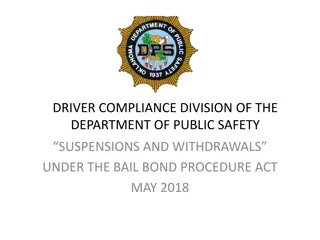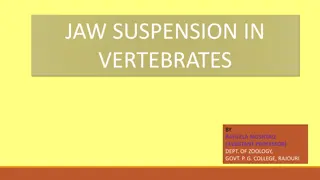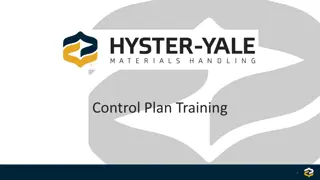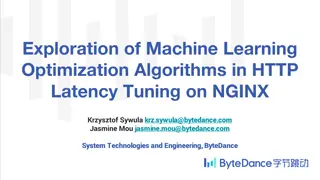External Review on Control and Tuning of Suspension Systems by Takanori Sekiguchi
Overview of the control design and implementation of digital systems for the KAGRA suspension control, focusing on local controls for SAS, GAS filter controller, IP controller, and noise study. Details include the purpose, configuration, and strategies for controlling thermal drift, mechanical resonances, and mirror velocity in various servo systems. The review also discusses sensor/actuator configurations and noise control techniques applied to improve performance.
Download Presentation

Please find below an Image/Link to download the presentation.
The content on the website is provided AS IS for your information and personal use only. It may not be sold, licensed, or shared on other websites without obtaining consent from the author.If you encounter any issues during the download, it is possible that the publisher has removed the file from their server.
You are allowed to download the files provided on this website for personal or commercial use, subject to the condition that they are used lawfully. All files are the property of their respective owners.
The content on the website is provided AS IS for your information and personal use only. It may not be sold, licensed, or shared on other websites without obtaining consent from the author.
E N D
Presentation Transcript
KAGRA 4th External Review Control and tuning of suspension T. Sekiguchi Takanori Sekiguchi External Review 1
Contents Overview of suspension control systems Control design (for type-B SAS) Implementation of digital control system in prototype SAS Takanori Sekiguchi External Review 2
Local controls for SAS Purpose Compensate the DC drift of low-frequency oscillators. Damp the mechanical resonances after earthquakes. Reduce the mirror RMS velocity for quick lock acquisition. Takanori Sekiguchi External Review 3
SAS Local control overview IP servo: DC position (X,Y) control Thermal drift control Pendulum mode damping GAS filter servo: DC position (Z) control Thermal drift control GAS filter mode damping Payload servo: DC alignment control Pendulum/rotation mode damping Takanori Sekiguchi External Review 4
IP Controller Sensor/actuator configuration Control Servo Similar configuration as TAMA-SAS/Virgo SA L-4C geophones as inertial sensors Sensor blending + SISO servo in Euclid coordinate space Takanori Sekiguchi External Review 5
Control noise study (in Type-B SAS) Simple viscous-damping control with various blending frequencies Blending frequency should be set <100 mHz to reduce mirror RMS velocity Noise coupling from geophone might be a problem if we raise the control gain at low frequencies for DC control Takanori Sekiguchi External Review 6
GAS filter controller Sensor/actuator configuration Fishing rod LVDT Voice-coil actuator Simple DC servo will be applied to each GAS filter to compensate the thermal drift (typically ~0.7 mm/oC) Damping servo will not be required because of low Q(~10) of oscillation modes Motorized spring (fishing rod) for initial DC positioning Takanori Sekiguchi External Review 7
Payload Controller Sensor/actuator configuration Control system diagram (OSEM) 6 OSEMs on intermediate mass 4 OSEMs on the mirror OSEMs are used to damp the resonant modes. DC alignment should be set by optical lever/WFS signals. The intermediate mass has moving (motorized) masses to set DC tilt. Takanori Sekiguchi External Review 8
Active damping performance Resonant frequency vs decay time in simulation 1/e decay time gets less than 1 min. for most resonant modes One exception: the mirror- RM lateral mode Takanori Sekiguchi External Review 9
Sensor noise coupling * Assuming the sensing noise measured in prototype OSEM Sensor noise coupling with strong damping by OSEMs. Damping servo should be turned off during science run (at least about length DoF) Damping servo about other DoFs might be kept on (TBC) BS requirement in science mode Takanori Sekiguchi External Review 10
Notes Actuator noise couplings are studied by Y. Michimura (JGW- T1503453). MATLAB codes and Simulink models for suspension control simulation: JGW-T1503606 Takanori Sekiguchi External Review 11
Implementation, Control Test in Prototype SAS Takanori Sekiguchi External Review 12
Digital control system for prototype SAS User interface (MEDM) for prototype SAS control IP GAS IM TM OpLev Takanori Sekiguchi External Review 13
Digital control system for prototype SAS Signal flow in each system: Coil matrix is set from the measurement so that it diagonalizes virtual actuators. Sensing matrix is determined from sensor layout geometry Takanori Sekiguchi External Review 14
Actuator diagonalization 1. 2. Coil matrix elements are set arbitrary (roughly set from actuator layout). Measuring the coupling from virtual actuators to virtual (local) sensors by actuating in different DoFs separately at a certain frequency (10-100 mHz). Calculating a new coil matrix from the measured coupling coefficients. Repeat the procedure 2 and 3 for several times. 3. 4. Procedure Transfer coefficient measurement We diagonalize actuators with local sensors in DC (at low freq.) Simple, but time consuming! Now writing a script to automatize it 1st guess Calculate New Coil Matrix Dnew= DoldE-1 Takanori Sekiguchi External Review 15
Transfer function measurement Measuring transfer functions from diagonalized actuators to virtual sensors Comparing with models Check if any fricting/broken part exists Takanori Sekiguchi External Review 16
Watchdog After large excitation: Geophone signals saturate and the control gets crazy. Optical lever beam spot goes away from QPD. Actuator signals saturate and no AC control is applied. We need a system automatically turns off the control / switch it to more robust one. Now we are designing software watchdog system (firstly aimed for long-term measurement of prototype SAS) Takanori Sekiguchi External Review 17
Summary We are developing local control system with control noise taken into account. Active damping works well, while one un-damped mechanical mode is found. Need to make control strategy: switching controls after lock acquisition? Control digital system is implemented for SAS prototype and now is working. Efficient way of actuator diagonalization and watchdog system are to be developed. Takanori Sekiguchi External Review 18
Appendix Takanori Sekiguchi External Review 19
Sensor/seismic noise model LVDT: measured noise Geophone: measured preamp noise Seismic: (<2 Hz) 90% percentile data of 1.5 year measurement in CLIO site, (>2 Hz) 1/f2interpolation Takanori Sekiguchi External Review 20
Blending filter Geophone noise raises at low frequency by ~f-3.5 Steeper high-pass is required to avoid noise coupling Blending filter with 7th order polynominal + + + 7 6 2 0 ) + 5 3 0 4 7 21 + 35 s s s s s s s = 0 ( ) , H s HP 7 ( s s 0 + + 4 0 3 5 0 2 6 0 7 0 35 21 s 7 s s s + s s s s = ( ) H s LP 7 ( ) s 0 Takanori Sekiguchi External Review 21























